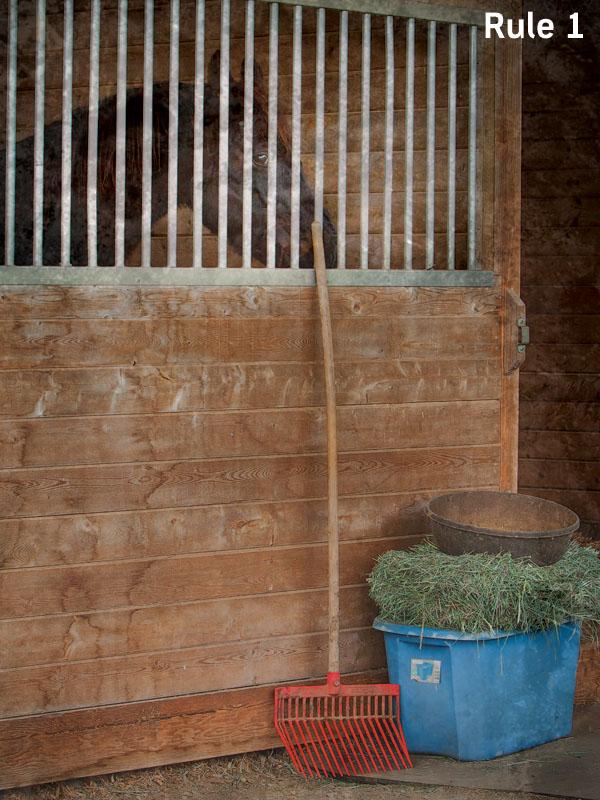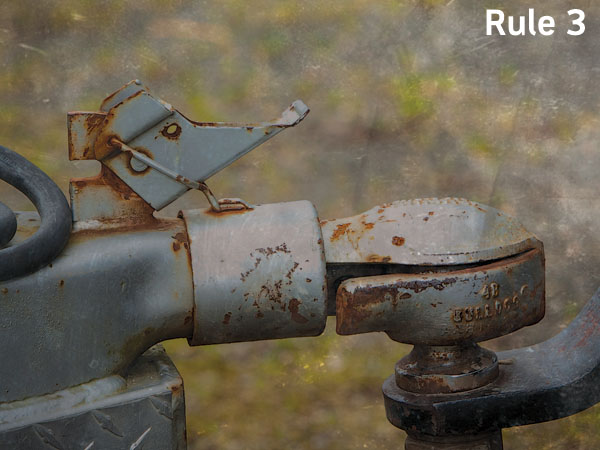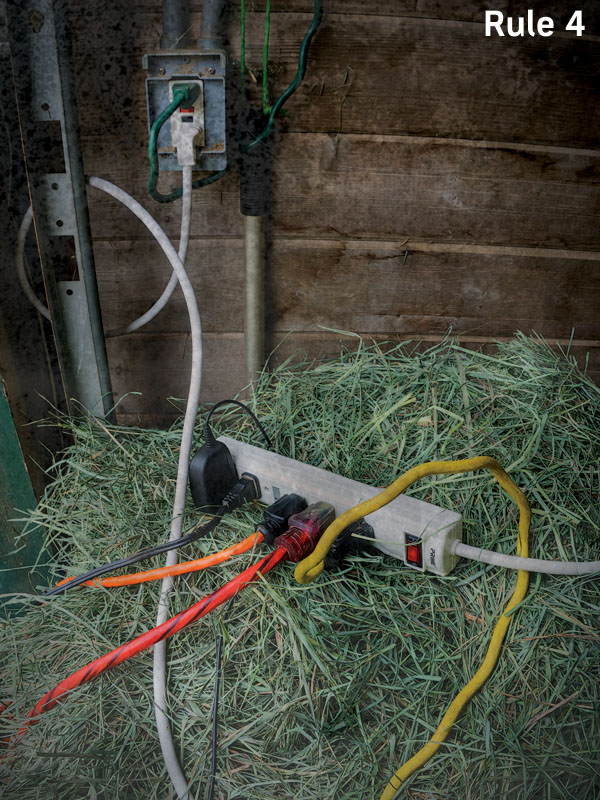My non-horsey husband is convinced that horses are suicidal.
He entertains dinner-party guests with stories he hears around the family table—imitating a horse that’s cast against a wall, or one trying to reach a nail that’s out of reach.
“Help me, I’m trapped in my bed,” he’ll wail, scrabbling with his hands to act out the poor cast horse’s plight.
Or, “If I can just reach a little bit higher, I think I can poke my eye.”
His stories leave people breathless from laughter, with tears in their eyes.

My stories, however, typically have the opposite effect. After more than 30 years in the trenches as an equine veterinarian, I’ve seen horses do things you’d never imagine possible—and many didn’t live to tell the tale.
I tell these stories to my clients when I see safety hazards in the barn, and they often cause a different kind of tears.
Now, I’m going to go public with some of my most horrifying stories. You’ll learn how everyday objects can be dangerous—even life-threatening.
My intent is for you to understand how important it is to pay attention to those little safety details in and around your barn.
Implement Incident
Rudy was a sweet, middle-aged gelding who lived in his owner’s small, private barn. It was a beautiful facility, with polished wood, custom stall fronts, and gleaming brass fittings. His owner took pride in her place, and Rudy always had the best of care.

Rudy’s owner was out of town at a business conference, and left her husband in charge. He dutifully fed the horses, cleaned the stalls, and scrubbed the water buckets, just like he was told. When he was through, he carefully placed the cleaning implements in the corner—leaning against the bars of Rudy’s stall.
The phone call came early the next morning.
“Something terrible has happened, Doc!” the panicked husband said. “I found Rudy lying down in his stall with the handle of a manure fork sticking out of his side. He isn’t breathing. I think he might be dead.”
Sure enough, Rudy had grabbed the handle of the manure fork, pulled it into his stall, and impaled himself. The only help I could provide was a phone number for the rendering service, and a sympathetic ear.
Rule #1: Never, ever leave a broom, shovel, pitchfork, or any other cleaning implement leaning against a stall door or window where your horse can reach it.
One step further: Horses are inquisitive, and often bored when they spend hours hanging in their stalls. If there’s anything nearby that could be dangerous, make sure your horse can’t reach it (including electrical outlets, especially if there’s something plugged in).
It’s also wise to pay close attention to maintenance issues, such as loose feeders with brackets that can be incredibly dangerous when exposed, or broken bucket hangers. I’ve sutured many a nostril after a horse had a failed piercing attempt.
Whip Whoops
Cash was a 7-year-old Arabian gelding, just starting a promising career as an endurance horse. His owner was longeing him in the arena one day when the horse stepped on a longe whip that had been left lying in the middle of a circle.
Have you ever seen those little white plastic fibers that make up the shaft of a whip? They’re often visible extending out of the tip of a broken whip.
When Cash stepped on the whip, he stumbled and the whip broke at just the right angle to cause those exposed plastic fibers to penetrate the skin just above his coronary band.

Cash’s owner pulled out the plastic fibers and scrubbed the area with antiseptic before putting him away. Her biggest concern was her expensive and now-broken whip.
By the next morning, however, her whip was the least of her concerns. She found Cash standing in his stall, holding his foot up. When she tried to walk him, he refused to put any weight on the leg. It turns out Cash had managed to drive that plastic fiber right into his coffin joint, which had rapidly become infected.
Joint infections are serious business. Cash was taken to surgery, where the joint was flushed, and treated with multiple antibiotics and anti-inflammatories. Even with aggressive therapy, the lameness didn’t improve at all.
In fact, it got worse. Cash stopped eating, and started spending a lot of time lying down to relieve his pain. Eventually, he foundered on the opposite foot. After several weeks with no improvement, his owner made the difficult decision to euthanize her promising young horse.
Rule #2: Never, ever leave a whip lying on the ground in the arena—or even in a barn aisle—where your horse might step on it.
One step further: Anything your horse steps on can lead to catastrophe if it penetrates a critical structure, such as the coffin joint or navicular bursae. Watch your arena footing, barn aisle, and even paddock areas closely for nails, wires, or other potentially dangerous objects.
It’s even wise to use a metal detector after every visit by your farrier to help clean up stray horse shoe nails that could cause trouble.
Trailer Trouble
Susan and Ron were loading up their two Quarter Horse geldings to haul to a local park for an evening summer trail ride after a busy day at work. Susan backed up the trailer and started getting hooked up before Ron took over so she could gather tack. It was the same routine they’d followed for years. With gear and horses loaded, they headed down the road.

They merged onto a busy freeway on the way to the nearby trails, when the trailer suddenly started swaying wildly behind the truck. In the blink of an eye, Ron lost control as the trailer whipped to the side, came unhooked and went careening into a truck in the next lane.
When the trailer flipped, Susan’s horse died instantly. Ron’s was trapped beneath the divider with a fractured femur and had to be euthanized when emergency personnel arrived. The driver of the other car was taken by ambulance to the hospital with a severe concussion and broken ribs, but he survived. No one else was injured.
When the police investigated the scene, they discovered the trailer hitch was open, with no pin in place. It appeared that someone had forgotten that critical finishing step when hooking up.
Susan and Ron were horrified when they realized that somewhere in their loading routine, they’d failed to communicate—and neither had double-checked to make sure the hook-up was complete.
Rule #3: Always check and double-check your trailer hook-up before driving away. It’s easy to become distracted when you’re in a hurry, and even easier to lose track of who’s in charge when multiple people are involved with loading up for a show or trail ride.
Make a habit of double-checking your hitch connection before you start your engine, and even consider stopping again at the end of the driveway if it’s possible, for a final check.
One step further: Trailer disasters rarely end well—and I have several stories with disastrous endings I could share, including one about the horse that was dragged down the road when the trailer floor collapsed.
Do your best to ensure trailer safety by paying close attention to routine maintenance, checking floors regularly, and spending time working with your horse to make sure he’s a happy traveler. (If your horse has developed bad trailering habits that could lead to safety concerns, see “Make Over Your Bad Hauler.”)
Fire Alarm!
Lucy had always dreamed of keeping her horses at home, and her six-stall barn was the answer to her prayers. Her old, retired gelding lived in one stall, while her current trail horse lived next door.
Her daughter had a pony, and she’d recently started a small breeding program. Her pregnant broodmare and a yearling filled up the rest of the barn. It was just what she’d always wanted.

Lucy had finished up the evening chores and was enjoying a nice glass of wine on her deck when a flash of orange caught her eye. In an instant, she watched her entire barn go up in flames. She raced back down the path to the barn, but by the time she got there it was too late—her horses were trapped in the inferno with no way out. Lucy’s dream became a nightmare.
Not a single one of Lucy’s horses survived the barn fire. When the fire department examined the scene, they determined that a single overloaded electrical outlet was to blame. A single spark was probably all it took to ignite the dry hay in the loft. And as they explained to Lucy, when a barn catches fire, it often burns quickly and ferociously.
Rule #4: Never, ever overload electrical outlets. Although electrical access can be frustrating in a barn, especially an older structure where outlets may be scarce, plugging too many appliances into a single outlet can be dangerous.
One step further: Barn fires almost always end with horrifying results. Do your best to protect your barn from fire by paying close attention to wiring, lights, and electrical outlets, and by performing repairs when necessary.
Whenever possible, store hay or straw in a separate structure, and make sure your barn is outfitted with a (working) fire extinguisher. Finally, never, ever allow smoking in the barn.
T-Post Trauma
The call came to me from the police department, which had been summoned to the scene when a passing motorist saw a horse impaled on a T-post by the side of the road.
When I arrived, the horse was barely responsive, with a thready heartbeat and a pool of blood at his feet. By the time we were able to locate the owner for permission to euthanize, the poor horse had died on his own.

And this isn’t the only story I have to tell about an uncapped T-post leading to a horse’s demise. Many years ago, I saw a horse led through a pasture gate by his young owner with an English-style stirrup that hadn’t been run up. The dangling stirrup got hung-up on a T-post, causing the horse to panic and run frantically around the post. That horse also lost his life when he ultimately impaled himself on the post.
Rule #5: If you have T-posts on your property, cap them! Commercially available T-post caps are inexpensive and easy to obtain at any feed or farm store. In a pinch, a tennis ball will also do the trick. (As an aside…don’t lead your horse around with English-style stirrups dangling.)
One step further: Fencing injuries are incredibly common. Although they’re rarely fatal, they can be, especially with T-posts.
Pay close attention not only to the type of fencing (just say no to barbed wire), but also to fencing maintenance.
Also, consider electrifying whatever type of fencing you choose as an extra insurance policy. The farther your horse stays away from the fences the better!






